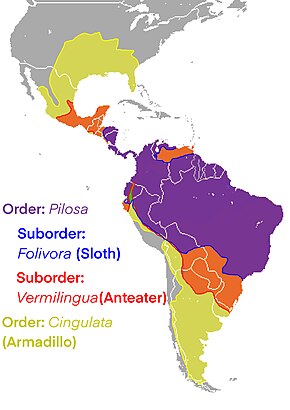
Back Xenarthra Afrikaans غريبات المفاصل Arabic غريبات المفاصل ARZ Xenarthra AST Kəmdişlilər Azerbaijani Няпоўназубыя BE-X-OLD Непълнозъби Bulgarian Xenarthra Breton Xenartres Catalan Xenarthra CEB
| Xenarthrans Temporal range: Late Paleocene –Recent,
| |
|---|---|

| |
| Clockwise from upper leff: Megatherium, giant anteater, two-toed sloth, nine-banded armadillo. | |
| Scientific classification | |
| Domain: | Eukaryota |
| Kingdom: | Animalia |
| Phylum: | Chordata |
| Class: | Mammalia |
| Infraclass: | Placentalia |
| Superorder: | Xenarthra Cope, 1889 |
| Orders and suborders | |
| |

| |
| Red: anteater, yellow: armadillo, blue: sloth, orange: both anteater and armadillo, green: both armadillo and sloth, purple: anteater, armadillo and sloth | |
Xenarthra (/zɛˈnɑːrθrə/; from Ancient Greek ξένος, xénos, "foreign, alien" + ἄρθρον, árthron, "joint") is a major clade of placental mammals native to the Americas. There are 31 living species: the anteaters, tree sloths, and armadillos.[1] Extinct xenarthrans include the glyptodonts, pampatheres and ground sloths. Xenarthrans originated in South America during the late Paleocene about 60 million years ago.[2] They evolved and diversified extensively in South America during the continent's long period of isolation in the early to mid Cenozoic Era. They spread to the Antilles by the early Miocene and, starting about 3 million years ago, spread to Central and North America as part of the Great American Interchange.[3] Nearly all of the formerly abundant megafaunal xenarthrans became extinct at the end of the Pleistocene.
- ^ Vizcaíno, Sergio F.; Loughry, W. J., eds. (2008). The biology of the Xenarthra. Gainesville: University Press of Florida. ISBN 978-0-8130-3718-9. OCLC 741613153.
- ^ O'Leary, M. A.; Bloch, J. I.; Flynn, J. J.; Gaudin, T. J.; Giallombardo, A.; Giannini, N. P.; Cirranello, A. L. (2013). "The placental mammal ancestor and the post–K-Pg radiation of placentals". Science. 339 (6120): 662–667. Bibcode:2013Sci...339..662O. doi:10.1126/science.1229237. hdl:11336/7302. PMID 23393258. S2CID 206544776.
- ^ Woodburne, Michael O. (2010). "The Great American Biotic Interchange: Dispersals, Tectonics, Climate, Sea Level and Holding Pens". Journal of Mammalian Evolution. 17 (4): 245–264. doi:10.1007/s10914-010-9144-8. PMC 2987556. PMID 21125025.